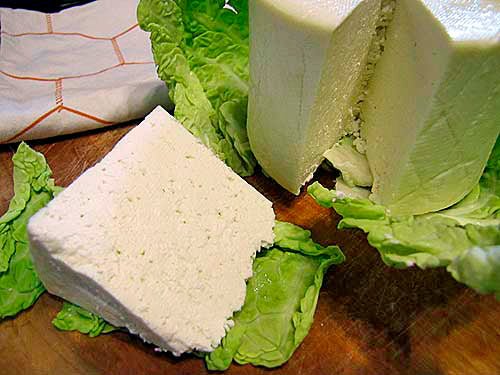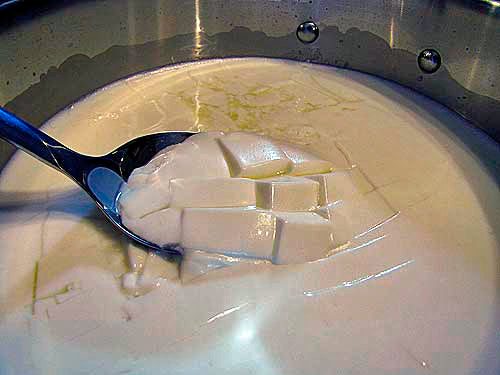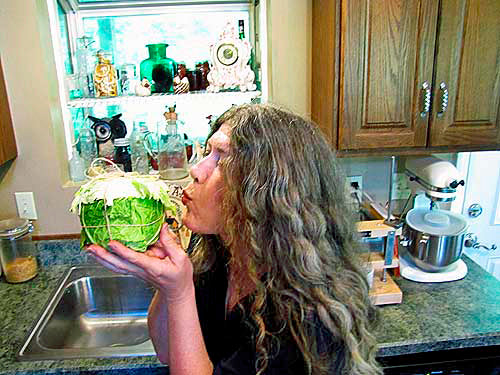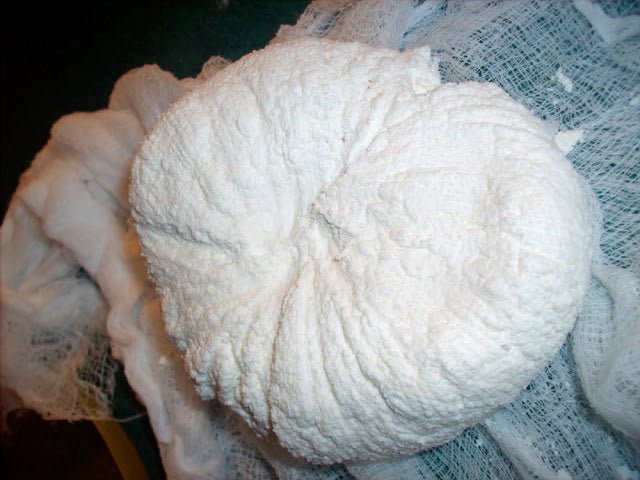 |
| Glory Bee and Suzanne sharing a moment! |
This one is her very favorite cheese, so far!
Suzanne has been searching high and low for a tasty cheese with a short aging time. This month she found it and she vows she will never let go.
Just in case you don’t know Suzanne, you can always meet her at her wonderful website- Chickens in the Road. While you’re there, check out her giveaway. (Note: This month’s giveaway is closed. Look for next month’s on June 15th.)
 |
| Suzanne milking Beulah Petunia, Glory Bee’s mother |
Make It Quick with Caerphilly
By Suzanne McMinn at Chickens in the Road
https://chickensintheroad.com/cooking/make-it-quick-with-caerphilly/
Caerphilly (pronounced CAR-filly) is a cute little town in Wales with a massive 13th-century castle. It’s also a cute little cheese that is aged in less than 3 weeks. That’s even quicker than Farmhouse Cheddar!
Several people have suggested Caerphilly to me recently. There is Caerphilly in the air! I decided this must be my next cheese in my cheese challenge for New England Cheesemaking!
In researching Caerphilly recipes, I found the most common recipe sprinkled about the internet on cheesemaking blogs is one adapted with slight variations from Making Artisan Cheese by Tim Smith. You can read an excellent post about that recipe here on the New England Cheesemaking blog (with videos) (click here). Like most cheeses, there’s more than one way to make a Caerphilly cheese, so I chose to tackle a recipe I found in 200 Easy Homemade Cheese Recipes, intrigued by this recipe’s inclusion of aroma mesophilic. The recipe in this book was for four gallons of milk. You can’t always just cut a cheese recipe in half, so I consulted with New England Cheesemaking and relied on their advice in adapting this recipe to the size most preferred for the average home cheesemaker who doesn’t want to make a mammoth cheese. Some of the instructions in this book were also on the vague side. Again, I relied on the cheesemaking experts at NEC to steer me in the right direction (info@cheesemaking.com).
If you’ve never tried Caerphilly, you could start with either this recipe or the Tim Smith version you can find at the NEC post (link above). If you’ve already tried the Tim Smith recipe, do give this one a whirl! With the addition of the aroma meso, it’s a creamier, more buttery take on Caerphilly.
If using store-bought pasteurized milk, for a two gallon recipe, you may want/need to add 1/4 teaspoon calcium chloride diluted in 1/4 cup cool water to the recipe. This will help the curds to set properly. See more about milk for cheesemaking here.
How to make Caerphilly:
2 gallons whole milk (cow or goat milk)
1/4 teaspoon direct-set mesophilic starter
1/4 teaspoon flora danica*
1/2 teaspoon liquid rennet (or 1/2 rennet tablet) diluted in 1/4 cup cool, unchlorinated water
cheese salt for brine
*You can use all regular mesophilic starter instead of half and half with the flora danica, but adding a portion of this special mesophilic starter (also known as aroma mesophilic) will give you a lighter texture and more butter-like flavor.
One-quarter teaspoon is approximately half of one of the little direct-set mesophilic packets. Carefully stir up the contents of the packet before measuring out the starter to be sure you get an even distribution of the culture.
Step 1. Heat the milk to 90-degrees F, stirring gently. Turn off heat.
Step 2. Sprinkle the mesosphilic and flora danica cultures over the surface of the milk.
Let stand for several minutes to rehydrate then stir thoroughly.
Cover and allow milk to ripen for 30 minutes.
Step 3. Add diluted calcium chloride, if using.
Step 4. Make sure temperature is 90 degrees. Add heat briefly if necessary. Add diluted rennet, stirring gently with an up-and-down motion. Cover and let sit for 45 minutes or until the curds give a clean break.
Step 5. Cut curds into 1/2-inch cubes. Let curds sit for 5 minutes.
It’s always difficult to get a photo of what “clean break” is. Here, I lifted some curds with a slotted spoon.
See how the curds retain their shape? If you have a clean break, you should be able to lift up some cut curds and they won’t slide back together in a milky mess, they’ll hold their shape. If you try to cut your curds and they keep sliding back together, your curds aren’t ready. (If you find that you regularly can’t get curds to hold their shape, you probably need to start using calcium chloride in your cheeses.)
Step 6. Return pot to low heat and warm curds to 95-degrees, stirring gently and continuously. This should take 30 minutes. Adjust heat as necessary to make sure it takes the entire time to reach 95. Do not heat too quickly. Turn off heat; cover and let sit for 45 minutes. When you look again, you’ll see the curds have been expelling the whey. The first time I ever saw curds and whey, I felt like I’d done a magic trick.
Step 7. Drain off whey.
Step 8. Line a 2-pound mold with cheesecloth and fill with curds. Press at 10 pounds for 30 minutes.
A big pot in the sink and a cheese press draining beside it–that’s a cheesemaking kitchen for you!
Step 9. Remove cheese from mold. Peel away cheesecloth, turn cheese over, and redress it. Press overnight (or about 12 hours) at 15 pounds pressure.
If you’re not sure if your cheese is pressed adequately, checking the weight is a guide.
This one checks in just under 2 pounds, the expected weight, so that looks good.
I’m slightly obsessive about cheesecloth imprints, so I usually put my cheeses back in the press for an hour or so–without cheesecloth–at the end of the pressing time just to smooth out the wrinkles a bit.
Wrinkles slightly smoothed out:
Another of the differences in this Caerphilly recipe than some others is the use of brine rather than adding salt to the cheese.
Step 10. Make a brine using cheese salt and cold water. The standard measurements for a brine are one gallon of water to 2 pounds of cheese salt. I make a reduced quantity of brine using that same ratio. (You could either make a full size brine and re-use it for more cheeses, or make a reduced brine based on the same ratio so that you aren’t using so much cheese salt. I prefer to not store brine since my fridge space is at a premium, so I take the latter approach.) Soak cheese in the brine solution for about 24 hours, turning once.
Step 11. Remove cheese from brine. Dry on a cheese mat at room temperature for 2-3 days, turning once or twice a day, until fairly dry to the touch.
Step 12. Wax, or allow to develop a natural rind. Age at 50- to 54-degrees for 2-3 weeks.
Yield: 2 pounds.
My experience: Caerphilly is an even quicker alternative to longer-aged cheeses than Farmhouse Cheddar. I think it has more flavor than Farmhouse Cheddar, and a nicer consistency. (Moist, like a Gouda, not crumbly like Farmhouse Cheddar.) It only takes a couple of hours to go from the pot to the press, so what’s not to love? Leaves were historically used to wrap many cheeses to protect cheese during aging and transport. Caerphilly was often wrapped in cabbage leaves, so that’s what I did with mine.
A conversation piece in your cheese cave!
I used Savoy cabbage leaves, washed and thoroughly air-dried. I wrapped the leaves around the cheese and tied it on with twine. You can do this just for presentation and serving, or throughout the short aging time of this cheese.
It’s a cheese pretty enough to kiss!
Seriously, this is the best cheese I’ve made so far, in both consistency and taste. It’s delicious, and it was hard to believe it was only aged for 2 weeks.
I haven’t tried this cheese without the addition of the aroma meso, and I won’t because along with the buttery flavor, I suspect the aroma meso and the brining gives this cheese the Cheddar-crossed-by-Gouda texture and taste. And you get it QUICK!!!
Suzanne’s Giveaway (Closed)
To help you get started making cheese, New England Cheesemaking is providing a package including (value of each item in parentheses): a hard cheese mold ($15.95), mesophilic culture ($5.95), veal rennet ($6.50), flora danica culture ($15.95), cheesecloth ($5.95), cheese salt ($2.95), and calcium chloride ($4.95). The total value of the package is $58.20. Note: This giveaway is open to U.S. residents only. (P.S. Or at least a U.S. shipping address. You can have a friend or relative send it on to you if they have a U.S. shipping address.)
For a chance to win: Leave a comment on Suzanne’s post and let her know you want it. ONE winner will be drawn by random comment number to receive the package. Eligible entry cut-off is midnight Eastern (U.S.) time tomorrow night (May 16). This post will be updated with the winner by 9 a.m. Eastern (U.S.) time on Tuesday (May 17). Return to this post to claim your prize!





























































































































































